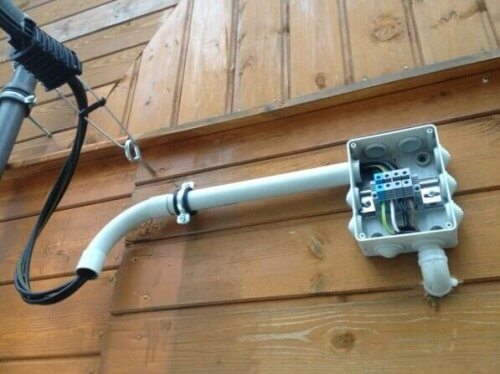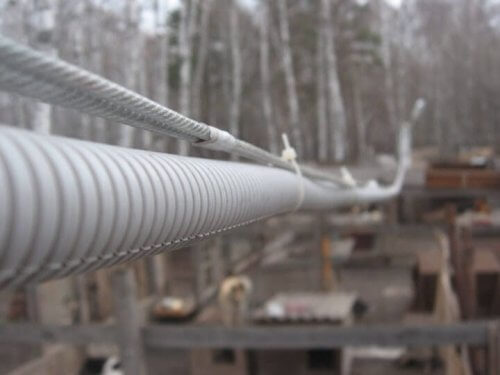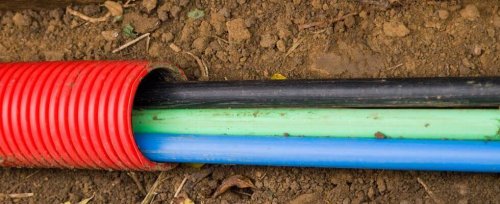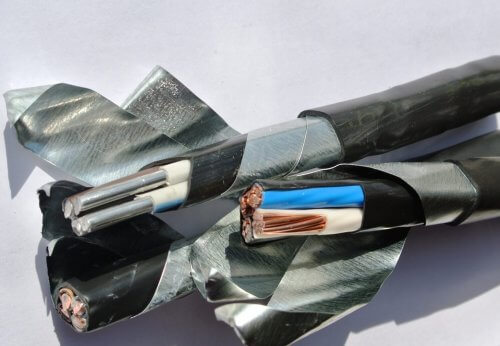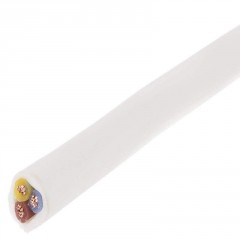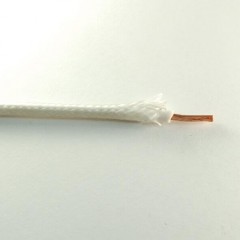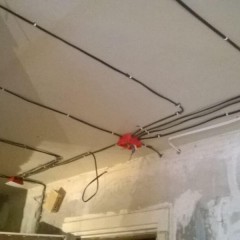Which cable to choose for laying outdoors (by air and in the ground)
Negative factors for street wiring
Cable lines laid in the open are subject to several negative factors:
- Ultra-violet rays. Sunlight adversely affects some types of insulation of conductors. This process is long and difficult to control. Therefore, you should choose products with insulation from materials that are not destroyed under the influence of UV rays.
- Ambient temperature Low may cause cracking of the insulation. Therefore, when choosing cables and wires, you should find out their range of operating temperatures. The installation temperature should also be taken into account. Usually it is not lower than 20 degrees of frost.
- Wind. Strong winds can damage both the sheath of the cable line and the cores inside. If the cable is laid down the street, the climatic installation area should be taken into account.
- Ice. If the external network is carried out in areas where there is an increased formation of ice in winter, this factor should be taken into account. A conductor covered with an ice crust can become several times heavier and tear under its weight during long spans.
There are three ways to lay the cable on the street and each of them has its own advantages and disadvantages:
- Through the air. The fastest way to install. The disadvantages of this method: it requires reliable fastening of cables, the susceptibility of lines to the negative effects of weather conditions.
- On the walls of buildings. For such a method, it is much easier to choose the material of the conductor. Disadvantages: labor-intensive installation, violation of the appearance of buildings, the negative effect on the conductor of ambient temperature and sunlight.
- In the ground. This method allows you to solve many problems. Weather conditions and sunlight have no effect. The appearance of buildings and the surrounding area is not violated. The disadvantage is the laboriousness of wiring, in some cases with the need to attract construction equipment for excavation of the trench.
Overview of suitable cable brands
For laying outdoors in 220 V or 380 V networks, SIP and PVA wires, and VVG and VBbShv cables, as well as their varieties, are used.
SIP - self-supporting insulated wire. The core material is aluminum; there are options with a steel core inside aluminum. Also exist types of SIP with bare carrier neutral. It is used for overhead power lines. The insulation of the wire is made of cross-linked polyethylene.It is durable and resistant to UV rays, so it is used outdoors without corrugations. From the support of the power line, the SIP extends through the air to the house.
For the installation of a self-supporting wire, various hardware: piercing clamps, extensions, insulating boxes. Reliable power supply requires the use of all these devices. SIP connection with copper input into the house should be done through terminal blocks or bolted connection with the laying of a metal washer. SIP wire can be used for laying outdoors on the wall. In this case, it must be placed in corrugated pipe for protection against rubbing and mechanical damage.
Advantages:
- resistance to UV rays;
- high insulation strength;
- does not require additional cables for suspension.
Disadvantages:
- requires additional protection when laying on the wall.
PVA - vinyl insulated wire, connecting. The core is copper, multiwire. The number of cores is from 2 to 5, of various sections. The main purpose of this wire is extenders, connecting garden and garden equipment, power tools for home care. Due to its design, the wire is very flexible and perfect for connecting, for example, lawn mowers in the country. The service life of this wire is 6 years, therefore PVA is not intended for wiring or connecting various objects.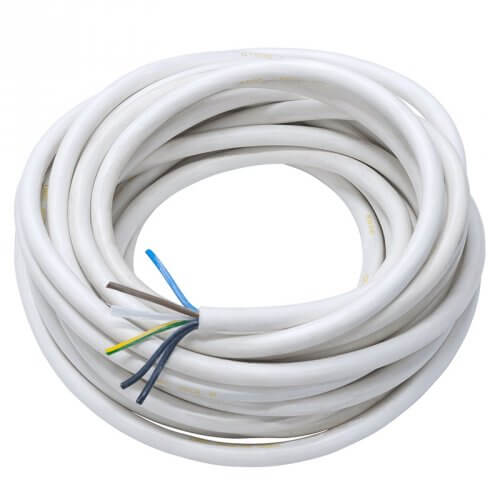
Advantages:
- flexibility;
- resistance to abrasion;
- thick insulation;
Disadvantages:
- short service life;
- limited scope.
VVG cable. It is the most versatile conductor for installation on the street, including outdoors. The brand stands for:
- B - vinyl core insulation;
- In - a vinyl cover;
- G - lack of armor (naked).
The cores are made of monolithic copper. If the initial letter is “A” (AVVG), then the core material is aluminum. The number of cores is from 2 to 5. At the moment, there are many options for such products with improved safety characteristics:
- VVGng - not supporting combustion;
- VVGNG-LS - flame retardant, with low smoke emission;
- VVGng-LT– non-burning, with low smoke toxicity;
VVG can be laid on the walls of buildings, structures, hang on a cable, lay in the ground. But in all these cases, the cable must be further protected. When mounting on the street, on walls and in other ways, the conductor is placed in a polyamide corrugated pipe, trays, metal hose.
When hanging on a cable - in a corrugated pipe, it is not worth using a gray PVC corrugation, since it is often not resistant to UV radiation (there is also a stable one, check with the manufacturer or on the package). It is better to use black or blue HDPE corrugation, made of polyamide, or a metal hose (when laying along a combustible surface, for example, on a facade).
For cable installation in the ground the conductor is also placed in the corrugation, but not in the same as shown above, but in a rigid corrugated HDPE pipe. This is to protect against mechanical damage.
Advantages:
- universality;
- long service life.
Disadvantages:
- requires additional protection when laying open.
VVG has a modification of VVSG. The letter "C" indicates the presence of a steel cable. This cable is self-supporting. Such a cable is used to connect objects through the air inside rooms, hangars, etc.
 The insulation of this conductor remained from PVC, so sunlight will destroy it. Use such conductors for suspension on the street should not be.
The insulation of this conductor remained from PVC, so sunlight will destroy it. Use such conductors for suspension on the street should not be.
VBBSHV. The core material is copper, there are aluminum analogues with the letter “A” at the beginning of the brand (AVBBSHV) Manufacturers produce these cables with a number of cores from 1 to 5. The brand stands for:
- B - vinyl core insulation;
- BB - armor without a pillow;
- Shv - a hose from vinyl.
This cable is designed for outdoor installation in the ground without additional protection.It can be mounted in trays on the walls of buildings, but due to its low flexibility, large weight and dimensions, this is difficult to do. It is recommended to insert a conductor into the pipe only when it passes under the road to reduce soil pressure.
Advantages:
- high resistance to mechanical damage;
- does not require additional protection.
Disadvantages:
- heavy weight;
- inconvenient in installation;
- grounding of the armor is required.
I would also like to talk about telephone cables. The installation technology of telephone conductors is similar to laying electrical. You can lay them through the air on a cable, along the walls of buildings, on fences. When installing in the ground, it is worth placing the telephone cable into the pipe or using armored conductors.
When pulling through the air, the PRPPMt cable is used. Such a conductor in the design has a cable for hanging.
Conclusion
To summarize, briefly indicating how to lay the cable on the street and which brand is suitable for different occasions:
- If you have VVG and its modifications - on the street it needs to be laid in a corrugation, resistant to UV radiation, or in a metal hose.
- By air, VVG is laid only on a cable and in a corrugation. The cable is needed to remove the load from the cores, the corrugation to protect against UV rays.
- Without a cable, you can lay SIP.
- If you want to lay a cable on the street in the ground, then VVG is laid in a pipe (corrugated from HDPE, or metal), and without a pipe you can lay armored cables of the VBBSHV type
- PVA, ballscrew and other wires are used for extension cords, transfers and other things, they are not suitable for wiring.
Now you know how to choose a cable for the street and what you need to additionally provide for. We hope the information provided was useful and interesting for you!
Related materials:


